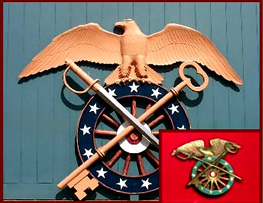2-8 September 1896
Quartermaster Branch Insignia
The Quartermaster Corps insignia was officially adopted on 3 September 1896, in War Department General Order No. 40. The emblem was designed by Captain Oscar F. Long at the direction of BG Richard N. Batchelder, The Quartermaster General.
 The original design was identical to the present insignia with the exception of the eagle surmounting the wheel. Captain Long’s design used the perched, flying eagle, head down just ready to “take off” in flight. It made a satisfactory device when cast in three dimensions, or in color. But the eagle’s head was “lost” when shown in silhouette — on the uniform collar or on buff and blue unit colors.
The original design was identical to the present insignia with the exception of the eagle surmounting the wheel. Captain Long’s design used the perched, flying eagle, head down just ready to “take off” in flight. It made a satisfactory device when cast in three dimensions, or in color. But the eagle’s head was “lost” when shown in silhouette — on the uniform collar or on buff and blue unit colors.
As a result, after World War I the Commission of Fine Arts in Washington D.C. redesigned the Quartermaster insignia so the eagle was clearly perched atop the wheel, with head raised and turned to one side.
Tradition has it that the Key symbolizes the Quartermaster role as Army storekeeper; the Sword stands for valor and indicates that supplies are military in nature; while the Wheel represents transportation and delivery of supplies. The 13 Stars and Spokes represent the original colonies and the origin of the Corps in the Revolutionary War. The Eagle is the national bird, and red, white, and blue are the national colors.
More information is available from the Quartermaster Corps & School website: Quartermaster History | Flags & Crests
Compiled by Dr. Steven Anders, former Quartermaster School historian.
Quote of the Week:
There is a soul to an army as well as to the individual man, and no general can accomplish the full work of his army unless he commands the soul of his men as well as their bodies and legs.— General William T. Sherman,
Personal Memoirs (1875)
